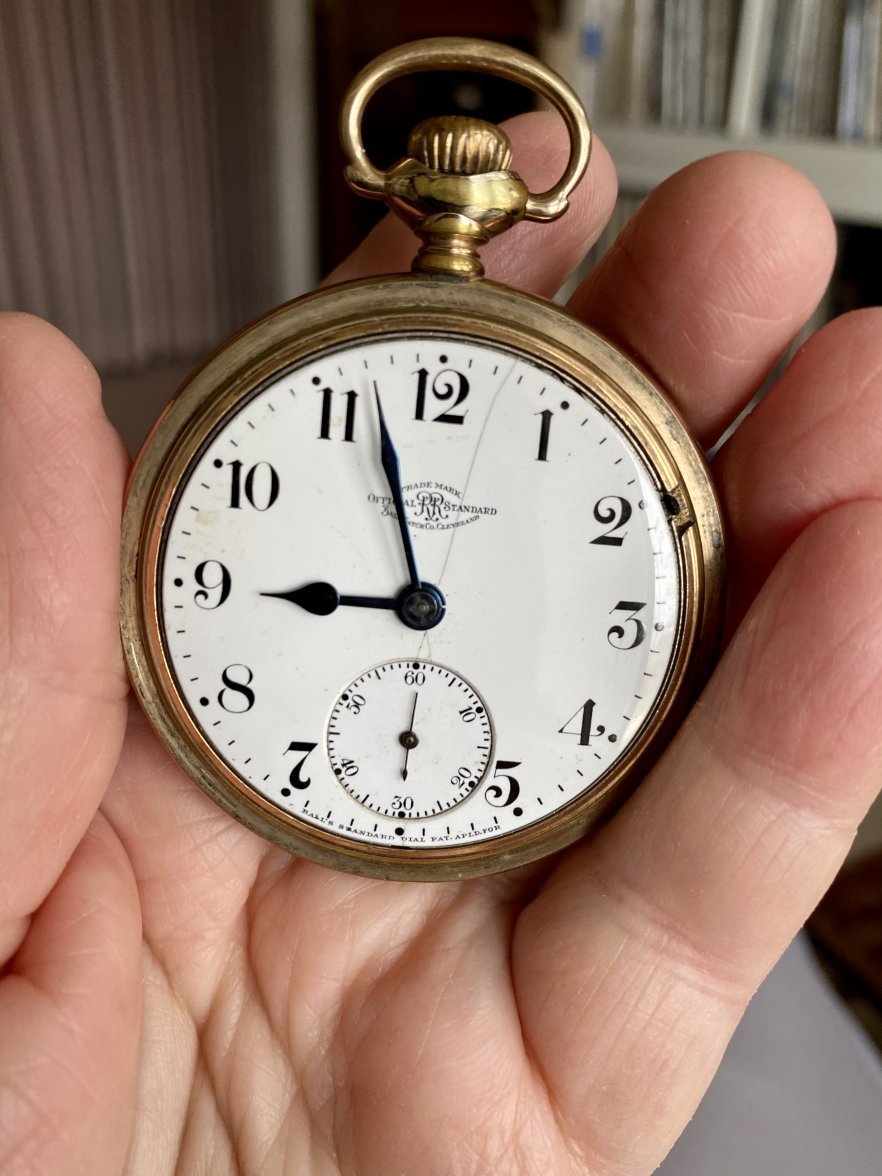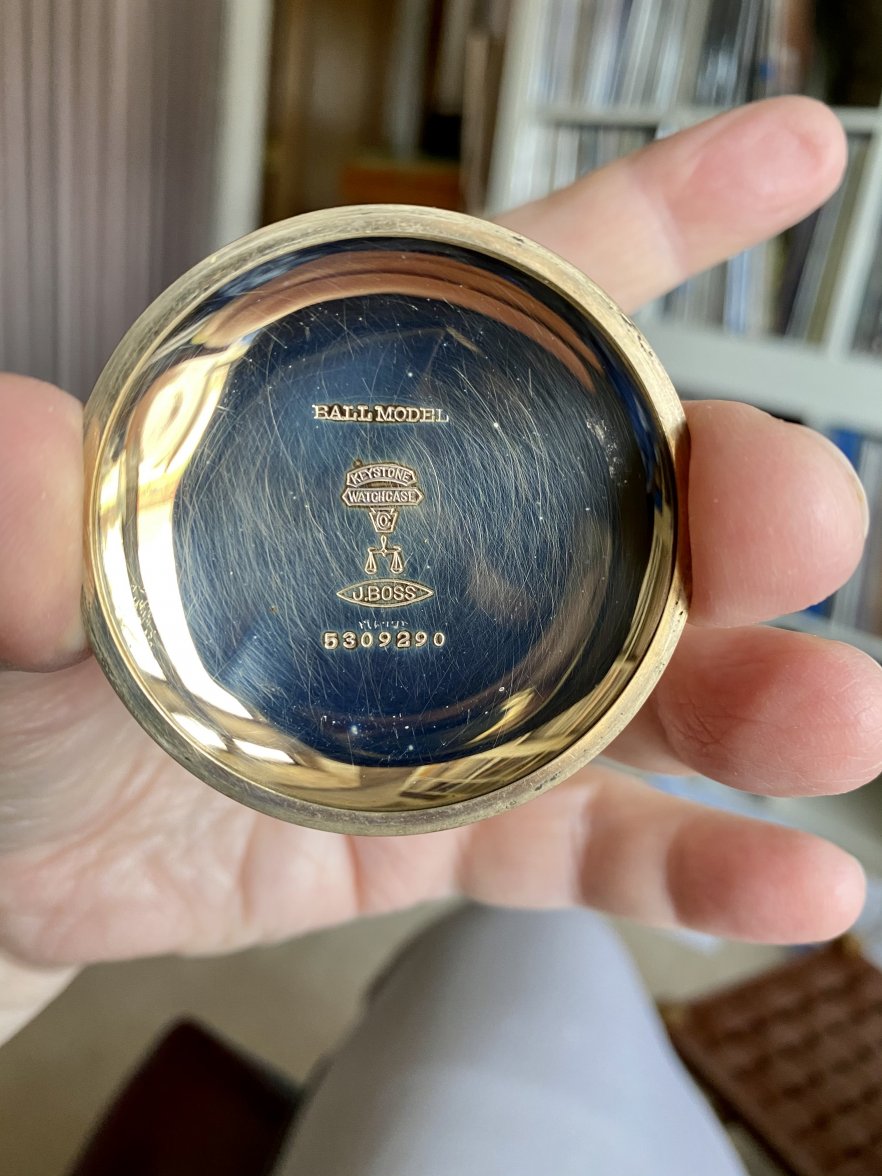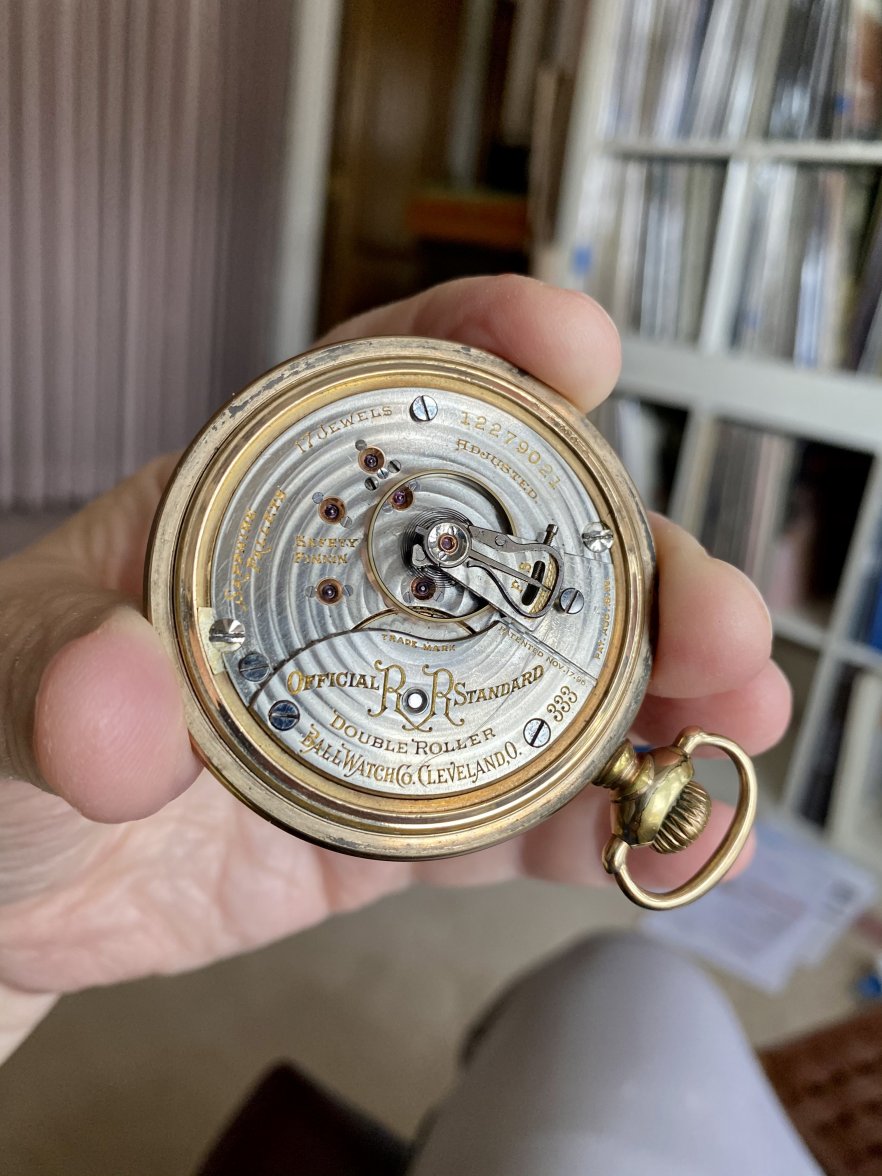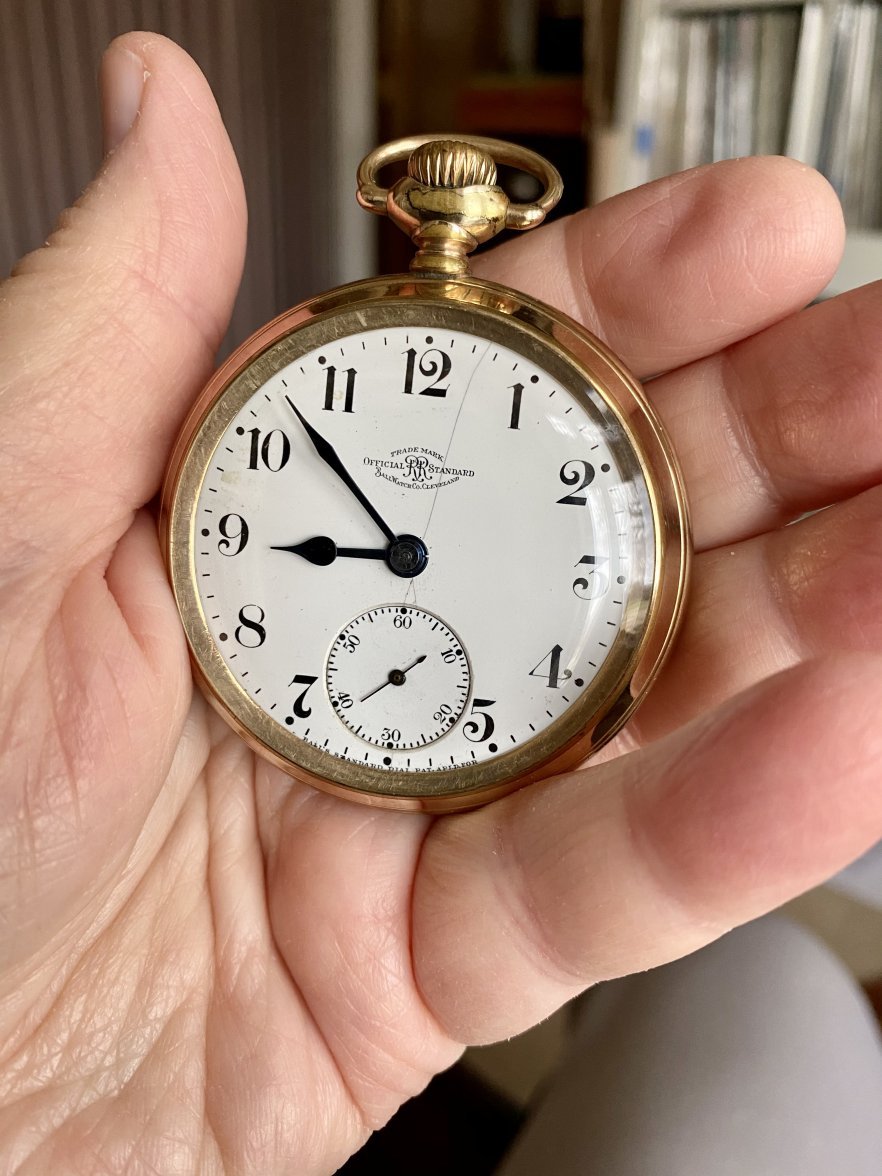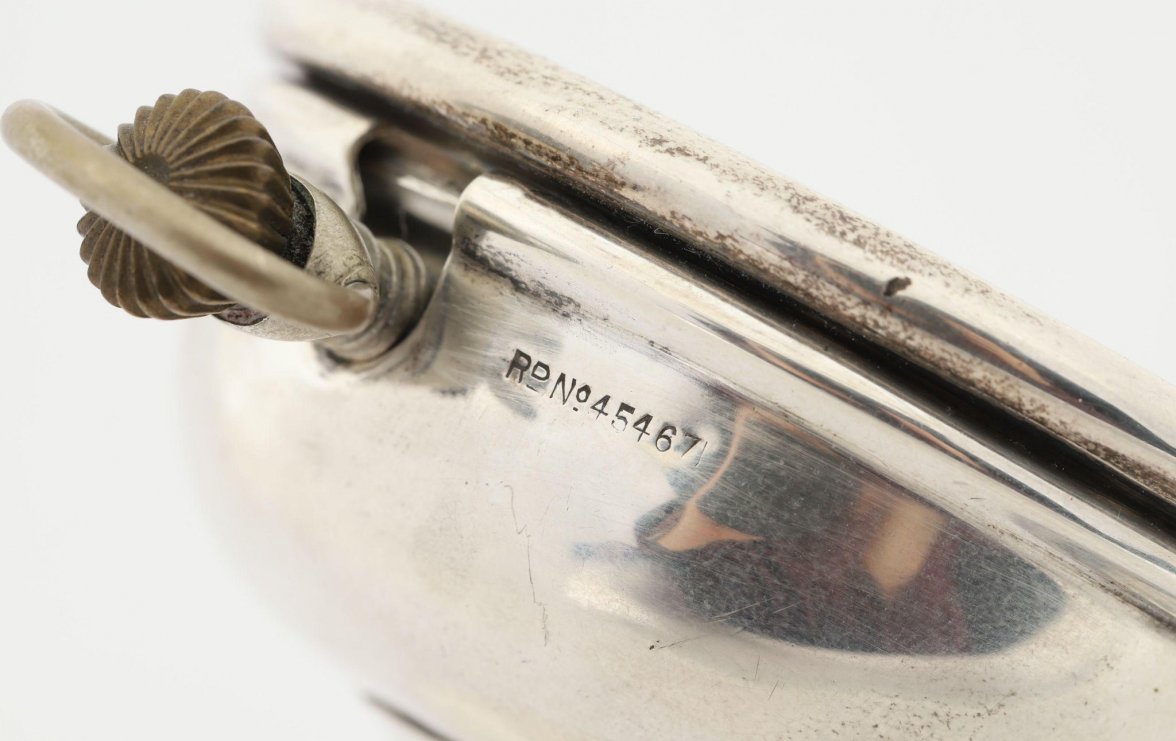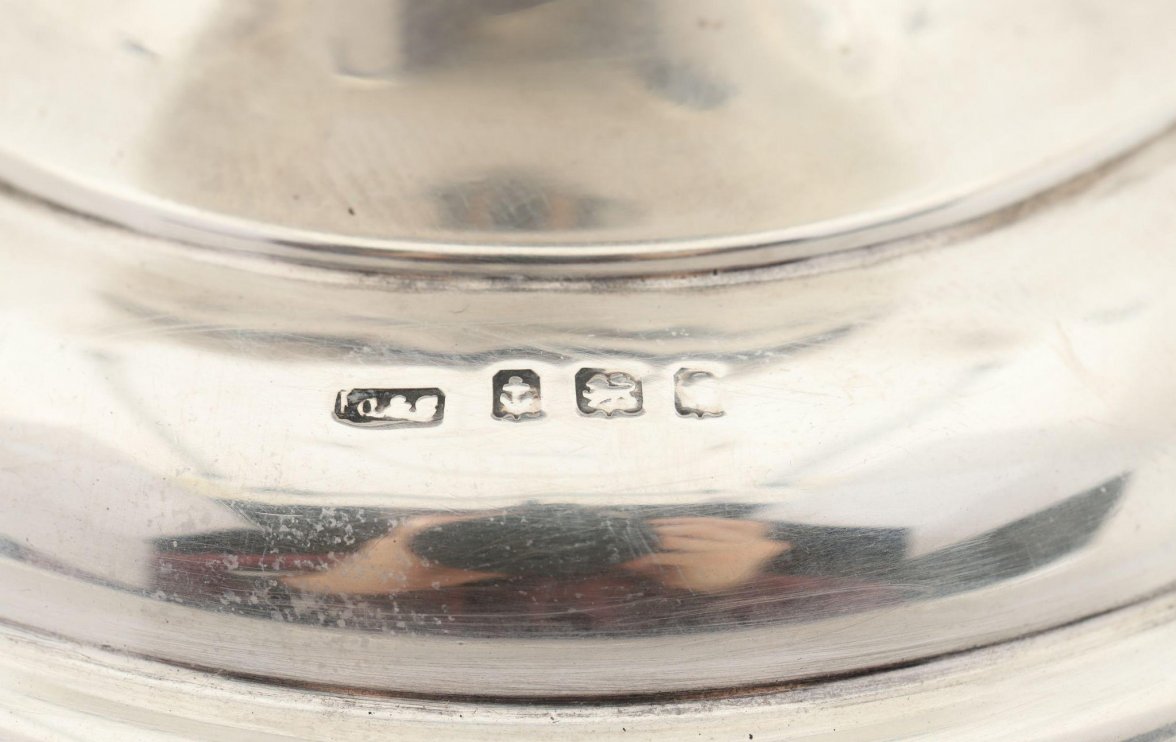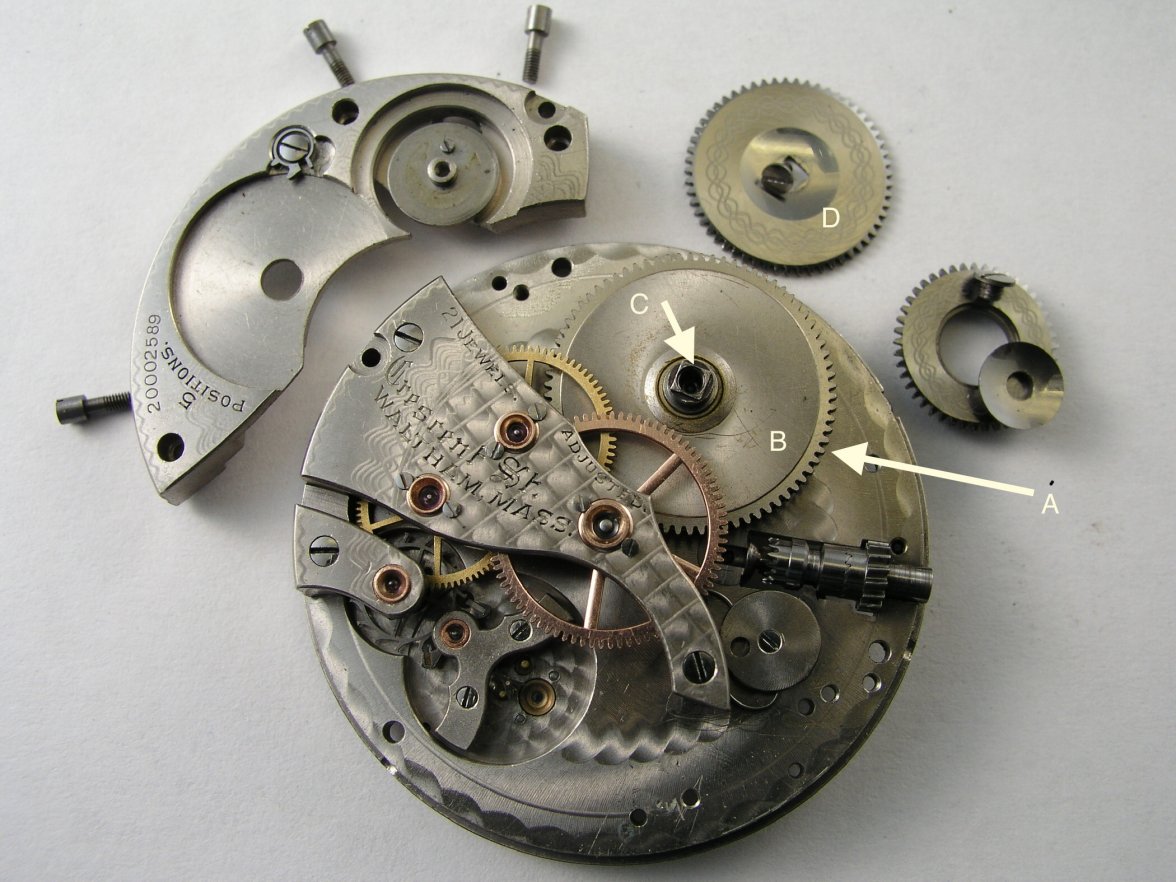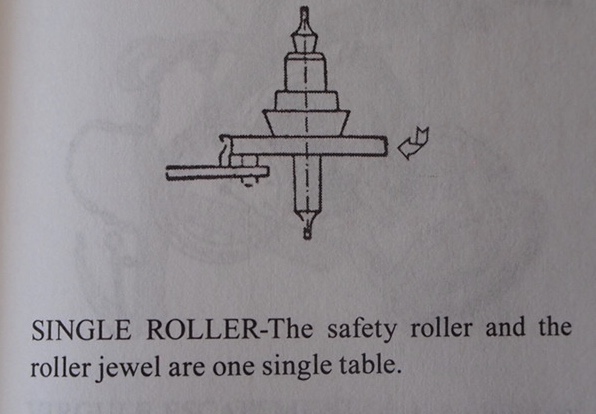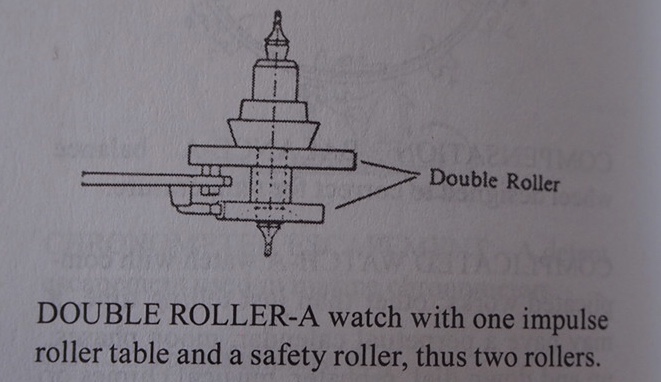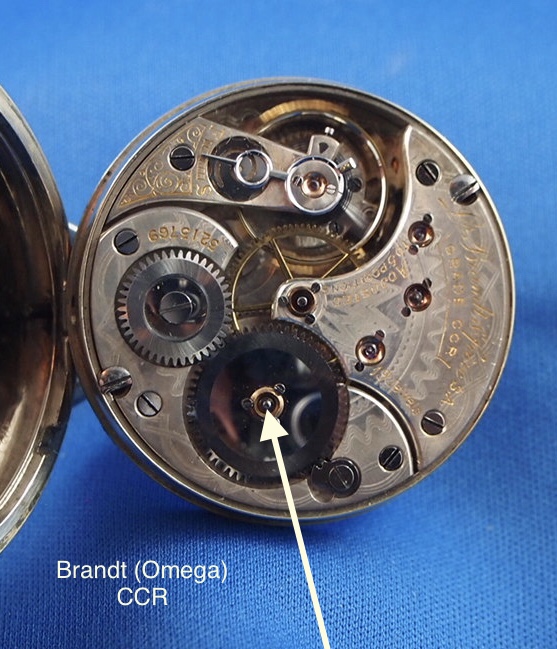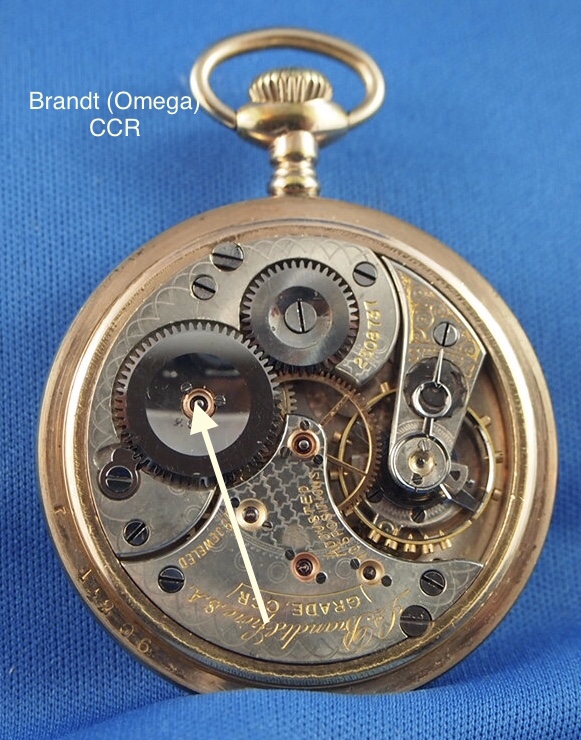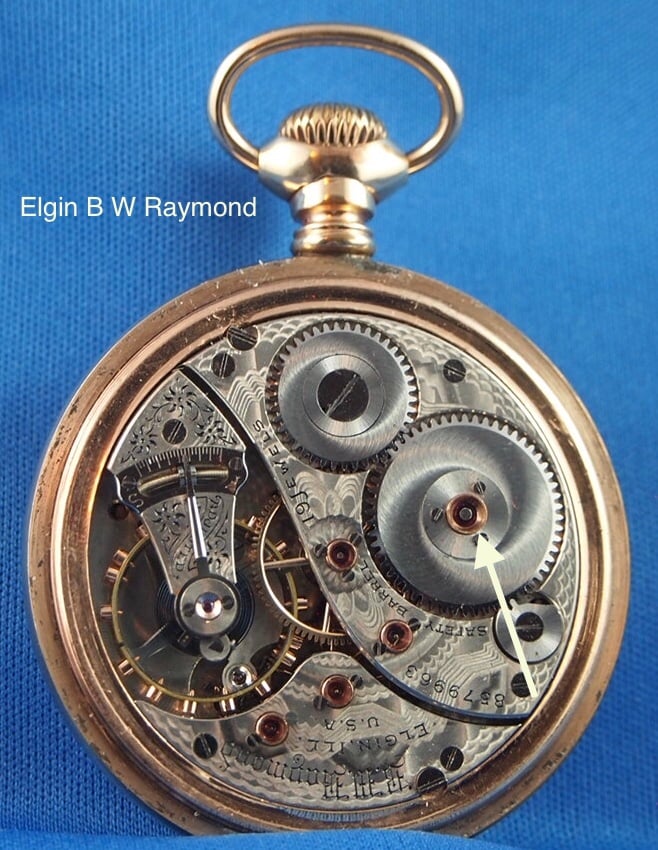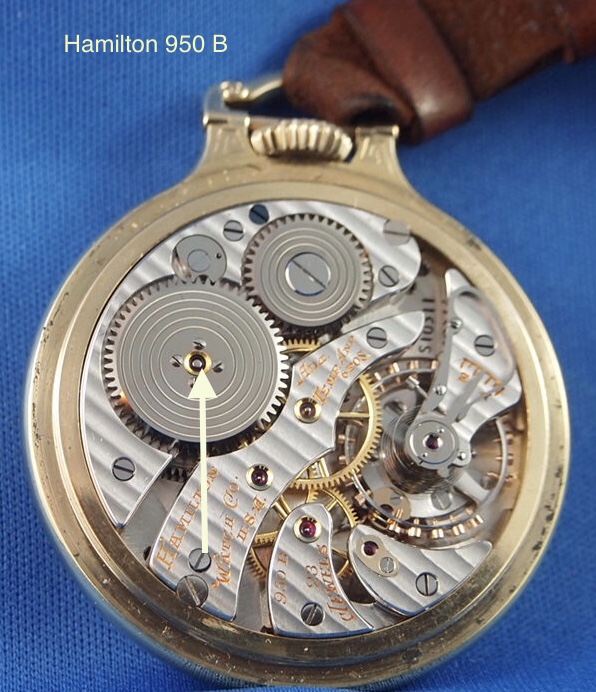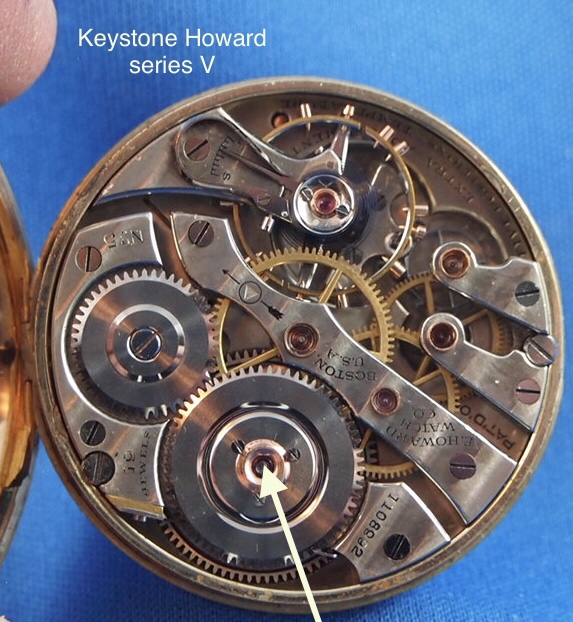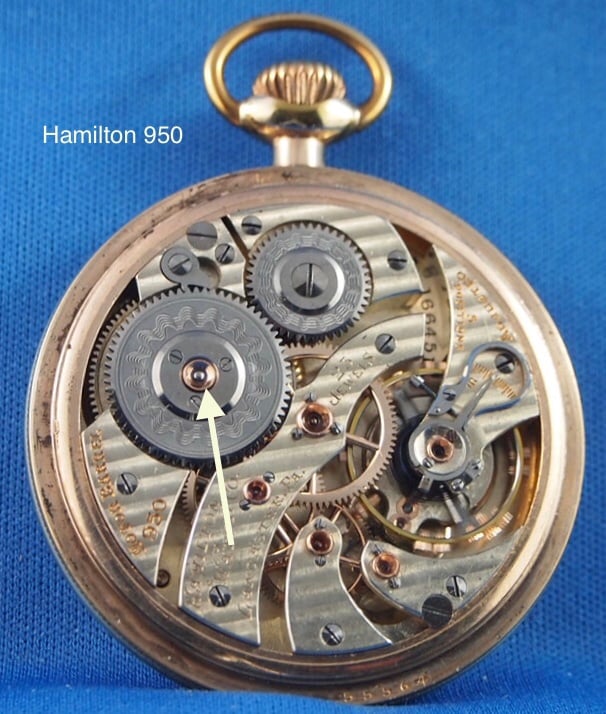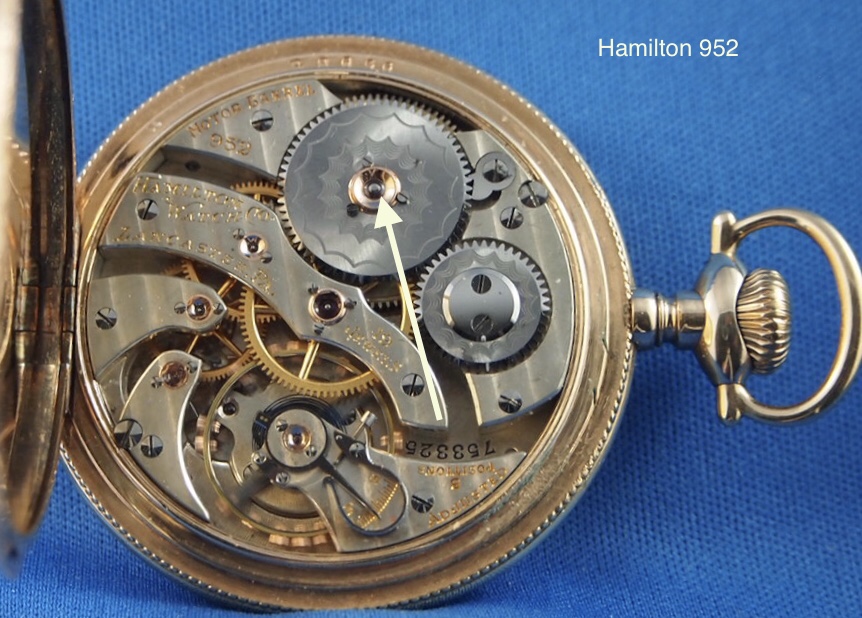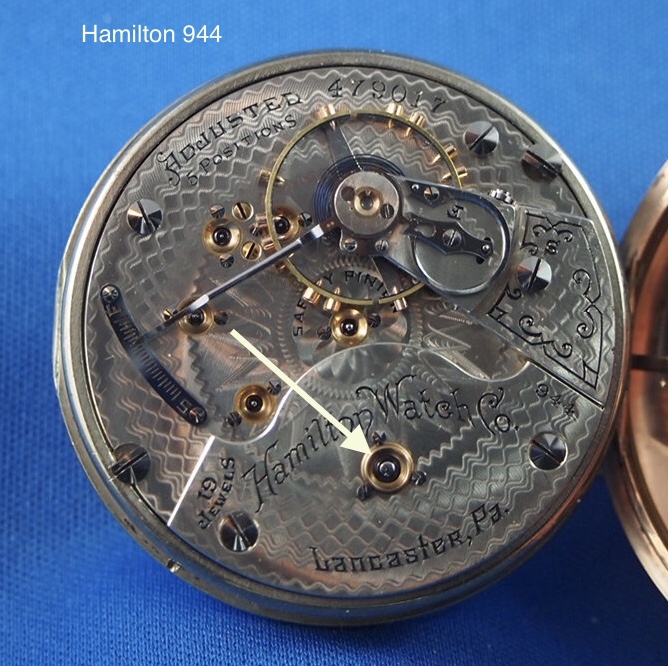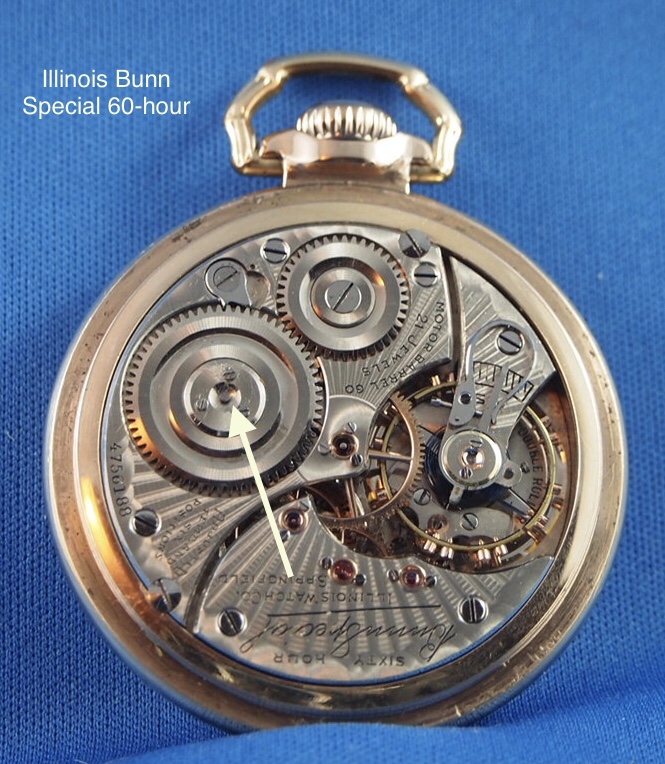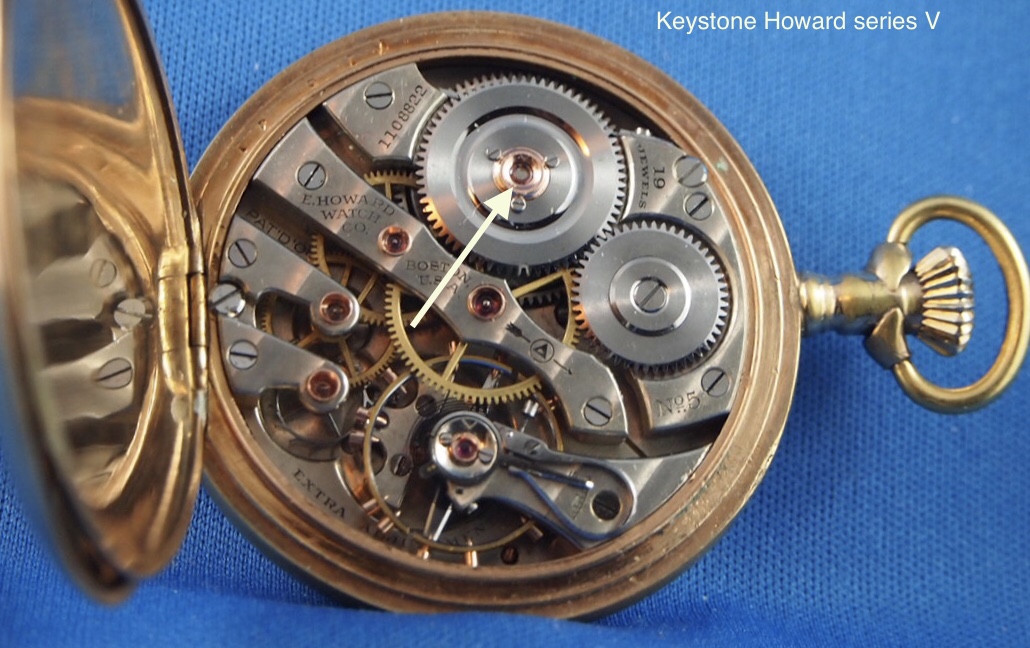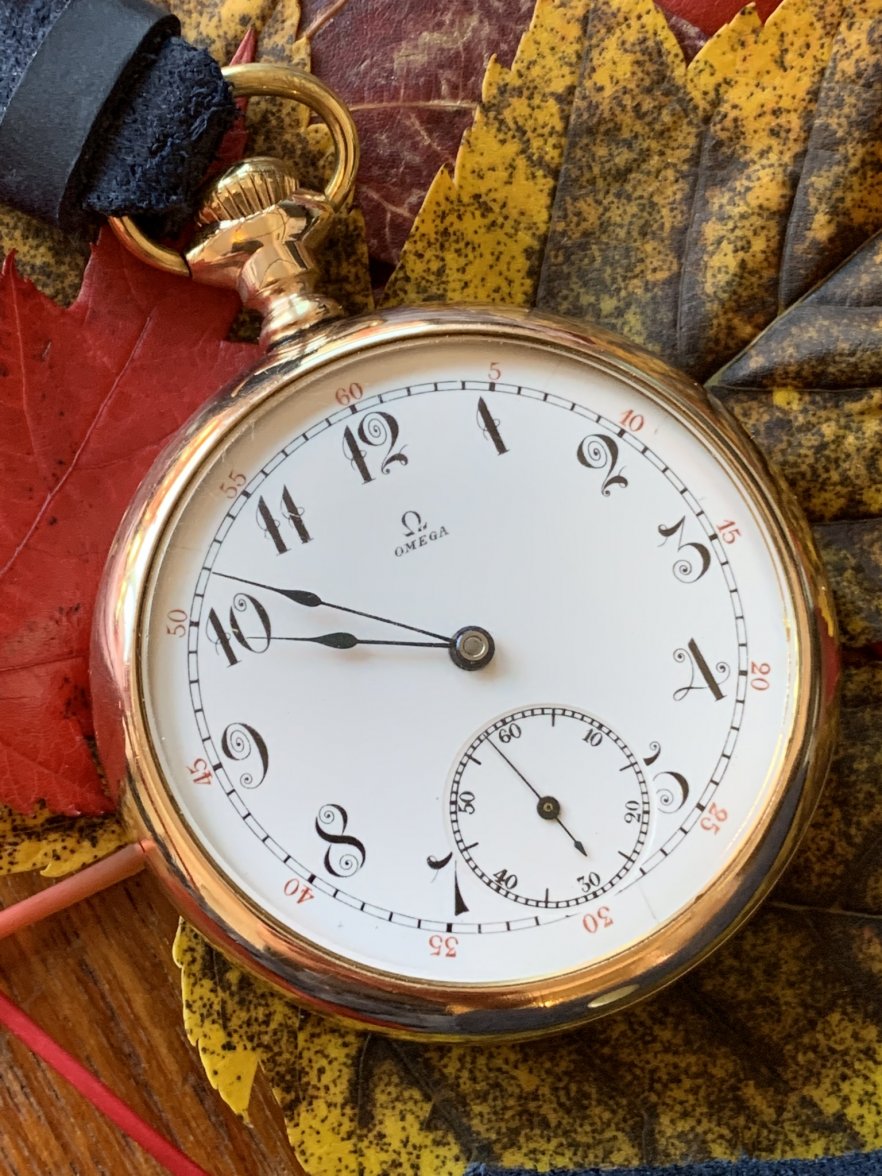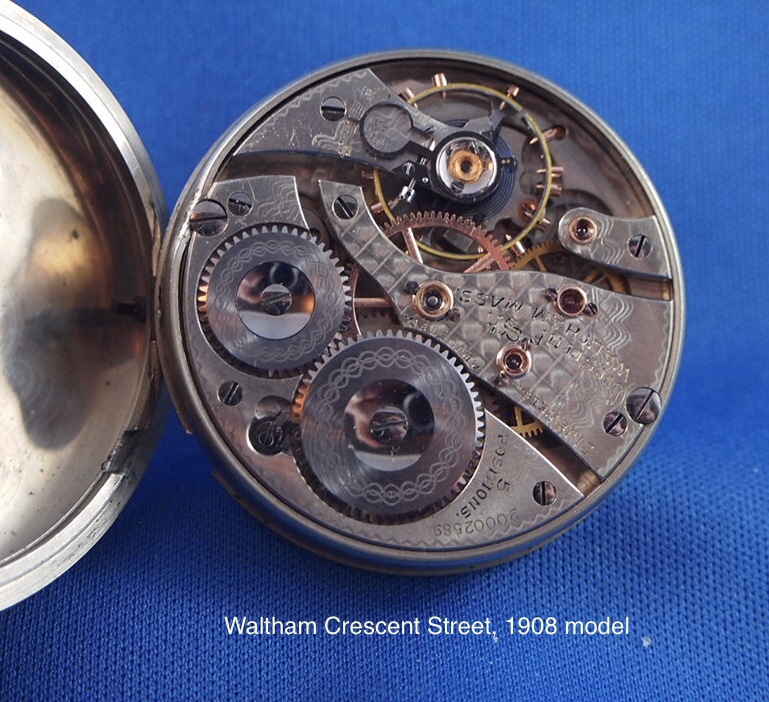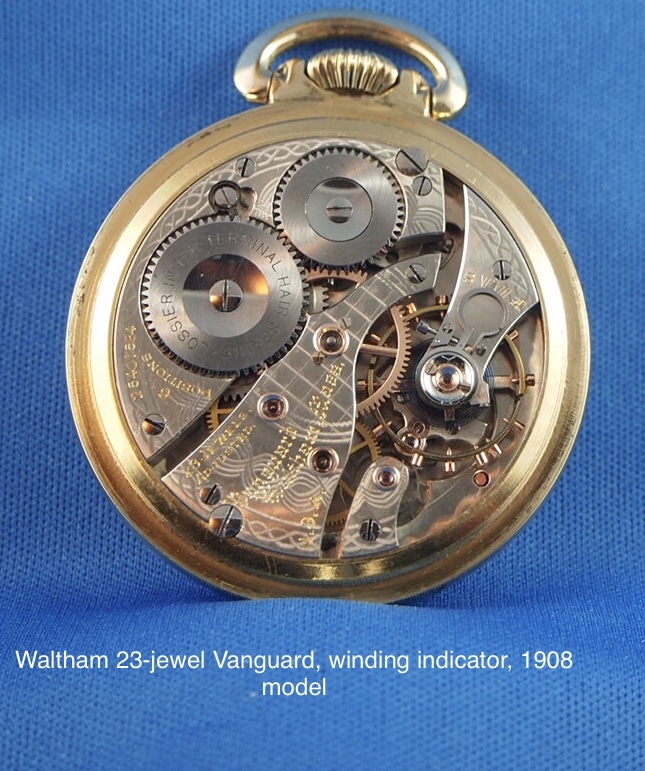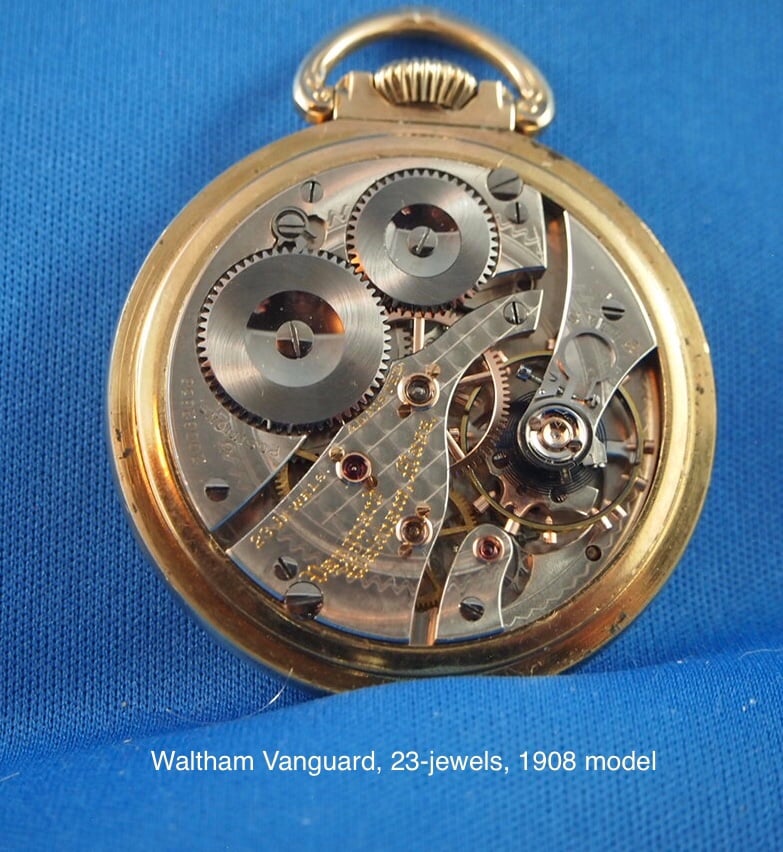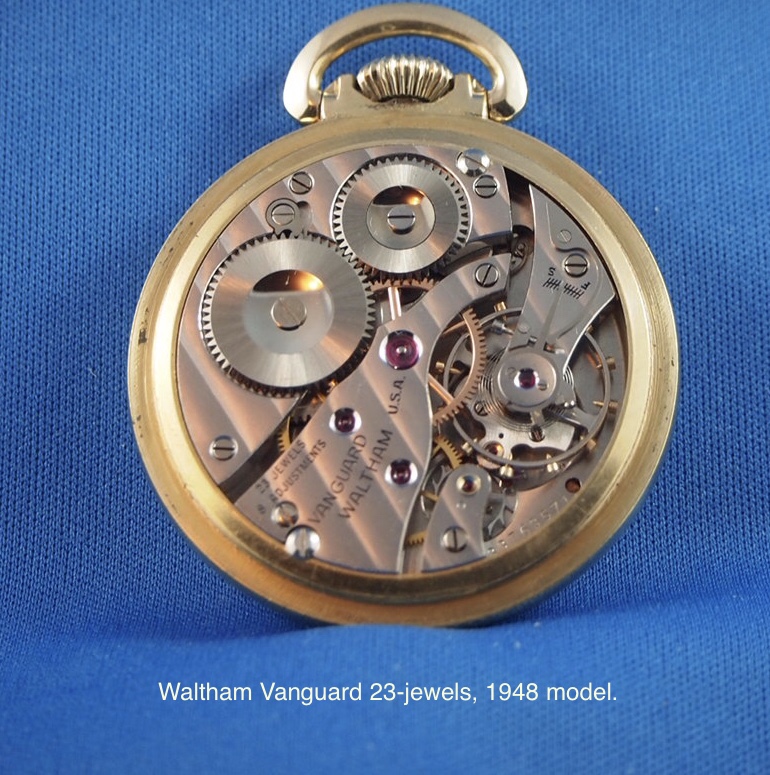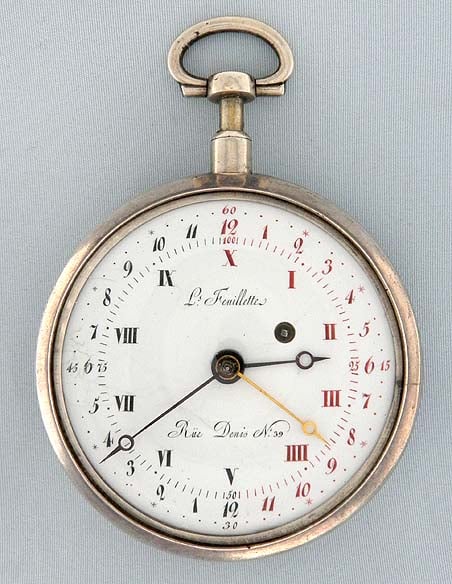Calling all Pocket Watch Buffs
DaveK
·Methinks I detect stampings on the base which look suspiciously like a hallmark, a date letter, a standard mark, and possibly a maker’s trade mark! Might that stand be sterling silver? Drop dead gorgeous. I have only one pocket watch stand. But it is so utilitarian compared to the subject stand, I am reluctant to show it. Matter of fact, it is so long since I have either used it or seen it, at the moment, I don’t know where it is!
It is sterling
Canuck
·Motor barrel: Two styles of mainspring barrels used in most watches. Going barrel, and motor barrel. Sometimes called “safely barrel. Here is a picture of a “motor barrel” from a 1908 Waltham Crescent Street, 16-size railroad watch. The example is in a Waltham, but it is the same principle in the Elgin.
In the first picture:
A- Mainspring barrel. The 15” long mainspring is wound into this barrel.
B- The first wheel. This wheel meshes with the gears in the watch to drive it
C- The C shows twice. This is the first wheel (B) arbor or axle. It is in two pieces.
D- The ratchet wheel. This is one of the gears that does the spring winding.
E- The ratchet wheel screw holds D onto the arbor C
Here is the barrel assembled, with the mainspring in the barrel. The barrel in place in the partially assembled movement.
In the second picture.
The letter callouts are the same as the letter callouts in the first picture.
A- The arrow points at the barrel, under the first wheel where you can’t see it.
B- The first wheel which drives the gears of the watch.
C- The arrow C points to the barrel arbor (axle).
D- This is the ratchet wheel which winds the mainspring.
Now, hopefully I can make sense of what you have seen. This is a motor (or safety) barrel. Without taking up the rest of your afternoon trying to understand, I’ll express the advantage of the motor barrel in the simplest of terms. When the mainspring is being wound, the barrel (A in both pictures) turns around the arbor, winding the spring from the outer end. The advantage with this system is, that if the mainspring breaks, its energy is expended outward where it is contained in the barrel. There is no “whiplash” on the first wheel (at B). This whiplash can destroy gears. Whiplash doesn’t happen with a motor barrel. Whiplash DOES happen on the other kind of barrel....the GOING barrel, when a mainspring breaks. Often resulting in broken gears.
In the first picture:
A- Mainspring barrel. The 15” long mainspring is wound into this barrel.
B- The first wheel. This wheel meshes with the gears in the watch to drive it
C- The C shows twice. This is the first wheel (B) arbor or axle. It is in two pieces.
D- The ratchet wheel. This is one of the gears that does the spring winding.
E- The ratchet wheel screw holds D onto the arbor C
Here is the barrel assembled, with the mainspring in the barrel. The barrel in place in the partially assembled movement.
In the second picture.
The letter callouts are the same as the letter callouts in the first picture.
A- The arrow points at the barrel, under the first wheel where you can’t see it.
B- The first wheel which drives the gears of the watch.
C- The arrow C points to the barrel arbor (axle).
D- This is the ratchet wheel which winds the mainspring.
Now, hopefully I can make sense of what you have seen. This is a motor (or safety) barrel. Without taking up the rest of your afternoon trying to understand, I’ll express the advantage of the motor barrel in the simplest of terms. When the mainspring is being wound, the barrel (A in both pictures) turns around the arbor, winding the spring from the outer end. The advantage with this system is, that if the mainspring breaks, its energy is expended outward where it is contained in the barrel. There is no “whiplash” on the first wheel (at B). This whiplash can destroy gears. Whiplash doesn’t happen with a motor barrel. Whiplash DOES happen on the other kind of barrel....the GOING barrel, when a mainspring breaks. Often resulting in broken gears.
Edited:
Canuck
·The roller table is fitted to the lower portion of the oscillating balance wheel. The roller table contains a tiny cylndrical jewel called a roller jewel. The roller jewel interacts with the escapement 5 (or 6, or 8, or 10 times a seconds. It depends on the watch). The escapement causes a watch to “tick”.
Up until circa 1892, railroad (or non-railroad) watches generally contained what is known as a single roller (roller table). See picture:
As standards or railroad watches became tighter after 1892, the double roller became necessary on a watch if it was to be railroad approved. See picture:
The doubler roller comprised two circular discs. One for the roller jewel, and the other was a “safety roller” to prevent the escapement from becoming “out of action” which would cause the watch to stop. The double roller table was felt to be more reliable in this regard.
Up until circa 1892, railroad (or non-railroad) watches generally contained what is known as a single roller (roller table). See picture:
As standards or railroad watches became tighter after 1892, the double roller became necessary on a watch if it was to be railroad approved. See picture:
The doubler roller comprised two circular discs. One for the roller jewel, and the other was a “safety roller” to prevent the escapement from becoming “out of action” which would cause the watch to stop. The double roller table was felt to be more reliable in this regard.
Canuck
·Elgin for Ball
Grade 333 17j circa 1906
18s RR grade and approved
Ball case by J. Boss/Keystone
Here’s the skinny on @TexOmega ’ s Elgin/Ball.
https://pocketwatchdatabase.com/search/result/elgin/12279021
Almost without exception, watches marked Official Railroad Standard (ORRS) by the Ball Watch Company, were standard production models as produced by the watch making firms that made watches for Ball. While the movement may be marked Ball, standard parts for that grade of watch produced by the watch making company, will fit the Ball watch. Ball bought his movements semi-finished, took them to his facility in Cleveland, Ohio, and performed the finishing, decorating, and adjusting, there. He was classed as a manufacturer.
noelekal
··Home For Wayward WatchesYea Canuck!
I even grasp that pretty well.
Thanks!
I even grasp that pretty well.
Thanks!
Canuck
·Further to the question on the motor barrel. The biggest difference between the motor barrel and the going barrel,is this:
Motor barrel (sometimes called a safety barrel): the outer end of the mainspring is “hooked” within the mainspring barrel wall. The inner end of the mainspring is “hooked” to the hub of the first wheel. When the watch is being wound, the mainspring barrel turns, thereby winding the mainspring from the OUTER end. If the mainspring breaks, its stored energy can be quite considerable. All that stored energy is released in a nano-second against the barrel wall. This spares the sensitive mechanism from great strain, and broken gears.
Going barrel: the outer end of the mainspring is hooked within the walls of the mainspring barrel. The inner end of the mainspring is hooked to the barrel arbor. This is the biggest difference between the two barrels. With the going barrel, it is the BARREL ARBOR that winds the mainspring from the inner end (not the outer end as with the motor barrel)! If the mainspring breaks, all the stored energy of the mainspring is released against the barrel wall which is geared directly with the gears of the watch! Serious damage can result!
Motor barrel (sometimes called a safety barrel): the outer end of the mainspring is “hooked” within the mainspring barrel wall. The inner end of the mainspring is “hooked” to the hub of the first wheel. When the watch is being wound, the mainspring barrel turns, thereby winding the mainspring from the OUTER end. If the mainspring breaks, its stored energy can be quite considerable. All that stored energy is released in a nano-second against the barrel wall. This spares the sensitive mechanism from great strain, and broken gears.
Going barrel: the outer end of the mainspring is hooked within the walls of the mainspring barrel. The inner end of the mainspring is hooked to the barrel arbor. This is the biggest difference between the two barrels. With the going barrel, it is the BARREL ARBOR that winds the mainspring from the inner end (not the outer end as with the motor barrel)! If the mainspring breaks, all the stored energy of the mainspring is released against the barrel wall which is geared directly with the gears of the watch! Serious damage can result!
Canuck
·This is a guide that will possibly help you determine if a watch has a motor barrel. This guide cannot be used on Waltham watches. They are a whole different topic. Look for the arrow in each picture which points at a bearing with a steel pivot in the middle. These bearings are all held in by 3 or 4 screws. There is a mixture of 16 size and 18 size watches. You may notice that, in the case of most of these watches, the exception being the Hamilton 944, there is a ratchet wheel with the bearing in the middle. You don’t see a ratchet wheel retaining screw like on most watches. There’s a bearing and a pivot in the middle of the ratchet wheel, in place of a screw.
Edited:
noelekal
··Home For Wayward WatchesOk. This may be a WUS sort of question, but is there a pecking order of top movements from Hamilton, Illinois, and Elgin (or any other American maker)? Movements that are reliably accurate. Movements that are durable? Respected movements that one should seek in an American pocket watch acquisition?
Y'all can probably see where I'm going with this. After fighting the urge to start down the pocket watch rabbit hole for decades, I'm seeing a pocket watch(es) in my future.
Y'all can probably see where I'm going with this. After fighting the urge to start down the pocket watch rabbit hole for decades, I'm seeing a pocket watch(es) in my future.
Canuck
·Ok. This may be a WUS sort of question, but is there a pecking order of top movements from Hamilton, Illinois, and Elgin (or any other American maker)? Movements that are reliably accurate. Movements that are durable? Respected movements that one should seek in an American pocket watch acquisition?
Y'all can probably see where I'm going with this. After fighting the urge to start down the pocket watch rabbit hole for decades, I'm seeing a pocket watch(es) in my future.
@noelekal ,
I think you are indirectly asking what you should collect! I prefer American railroad grade, and railroad approved pocket watches, over Swiss, as a rule. But I do have two Swiss ones. As you peruse these pages, you may learn a lot by osmosis that will help you develop a feel for what you like best. Pecking order? There will be many answers to that question, and everyone will tell you what they like best. So, no help there. You should bear in mind a few factors:
1/ Price. What are you comfortable spending.
2/ Popular sizes among most collectors are A/ 16-size. B/ 18-size. C/ 12-size. Decide what your focus will be. Lots of
collect 12-size watches, but generally, they are not preferred.
3/ Style. Hunter case, or open face.
4/ Era. Lots of folks collect only key winders (19th century).
5/ 20th century. Or even 18th century.
6/ Material. Nickel silver, steel, coin silver, gold filled, karat gold.
7/ Condition, condition, condition. Bear in mind that the money you have to spend on repairs comes out of your
acquisitions budget. The more you spend on repairs, the fewer watches you’ll buy.
8/ Ask questions. While you are learning, ask for opinions on what interests you.
9/ Learn! Talk to others you know that collect. Get them to tell you what makes them hum.
10/ Exposure to other’s collections. Learn by osmosis.
11/ Buy carefully. A fixed up watch may never be as good as an excellent unrestored one. Better to have a few real
nice ones, than a lot of paperweights.
@DaveK has been exposed over time, on the MB. So has @Mad Dog . They have developed a feel for what will please them, but they haven’t rushed into collecting. They haven’t leapt at the first impulse. They have set goals, then they have picked and chosen until the right watch comes along. They may have had to pay more than they were comfortable with for some of the watches they’ve bought. But look at what they’ve bought! Neither are in a hurry. Oh, and by the way, you may note they’ve bought Hamilton, Elgin, Waltham, Illinois, etc.
Okay! Of the pedestal. I’m mostly a wrist watch collector, so wadda I know?
noelekal
··Home For Wayward WatchesOh yeah. Meant to list Waltham as well.
Thanks Canuck.
Both this thread and the Forum itself are a surprising resource on pocket watches. Only thing is, my "wanter button" is getting cranked up too high.
Thanks Canuck.
Both this thread and the Forum itself are a surprising resource on pocket watches. Only thing is, my "wanter button" is getting cranked up too high.
Canuck
·@noelekal ,
Lots of aspiring collectors start off with a Hamilton 992B. Lots around, so prices are in the comfort zone of many. Hamilton made 550,000 of them. The parts you are most likely to need are balance staffs, mainsprings, and crystals, and these parts are readily available. Repairs to 992Bs are more likely in the comfort zone of a lot of modern watchmakers. The older ones are tougher to work on. Cost of repairs are likely to be more palatable, as well. The 992B, competently serviced, will give as good performance today as it did when new. Same might be said about Waltham 1623 (16-size, 23-jewels) like Vanguard. But prices likely higher. Elgin grade 571 B W Raymond, same goes.
What motivates me is totally different to what motivates most collectors. I do my own work. So I don’t need to factor in the cost of repairing and maintaining a collection. Plus, I’m a “bottom feeder”. Sweat equity can go a long way to turn an average watch into a “headliner!”
Lots of aspiring collectors start off with a Hamilton 992B. Lots around, so prices are in the comfort zone of many. Hamilton made 550,000 of them. The parts you are most likely to need are balance staffs, mainsprings, and crystals, and these parts are readily available. Repairs to 992Bs are more likely in the comfort zone of a lot of modern watchmakers. The older ones are tougher to work on. Cost of repairs are likely to be more palatable, as well. The 992B, competently serviced, will give as good performance today as it did when new. Same might be said about Waltham 1623 (16-size, 23-jewels) like Vanguard. But prices likely higher. Elgin grade 571 B W Raymond, same goes.
What motivates me is totally different to what motivates most collectors. I do my own work. So I don’t need to factor in the cost of repairing and maintaining a collection. Plus, I’m a “bottom feeder”. Sweat equity can go a long way to turn an average watch into a “headliner!”
Waltesefalcon
·I'll second a Hamilton 992 or 992B as a good place to start.
DaveK
·My second pocket watch purchase was an auction lot of three watches. I sold one and recovered the cost of the whole lot, and sold the second one to service the third 😎 Sometimes you can have fun with building a collection that way, but the best money is on focused, careful & patient hunting. Still, this was a fun pickup, now serviced, and literally free
Canuck
·Regarding motor barrels, and Waltham pocket watches. The tell tale signs as to whether a particular Waltham has a motor barrel or not, don’t exist. All 1892 model, 18-size Walthams, all grades, have motor barrels. All 1899, 1908, and 1948, 16-size Walthams, all grades, have motor barrels. Compare these four Waltham examples with the examples shown in the previous post where motor barrel movements are shown. Check the centre of the ratchet wheel on these Walthams. There is a SCREW there, not a bearing with a pivot. These Walthams all have motor barrels. But Waltham did it their way.
Edited:
DaveK
·140dave
·Just to keep the Motor barrel topic going a bit....
The terms "motor-barrel" and "safety-barrel" are sometimes used interchangeably, but they are slightly different versions of the same idea. The Safety Barrel was used primarily by Waltham and Elgin in a lot of their watches. In a safety-barrel watch, the barrel arbor and the barrel are attached by means of a square hole at the bottom of the barrel, and a matching square shoulder on the arbor. Because of this more rigid connection of barrel and arbor, when the mainspring breaks the force is transmitted through the barrel to the arbor where the force can be expended by the ratchet wheel. The safety pinion really did the trick on a lot of watches, probably better than the motor barrel did. There is some debate with watchmakers on the Illinois Motor Barrel, if it is a "true" motor barrel as the mainspring is attached more like a going barrel and somewhat negates the ability to release the power harmlessly.
The terms "motor-barrel" and "safety-barrel" are sometimes used interchangeably, but they are slightly different versions of the same idea. The Safety Barrel was used primarily by Waltham and Elgin in a lot of their watches. In a safety-barrel watch, the barrel arbor and the barrel are attached by means of a square hole at the bottom of the barrel, and a matching square shoulder on the arbor. Because of this more rigid connection of barrel and arbor, when the mainspring breaks the force is transmitted through the barrel to the arbor where the force can be expended by the ratchet wheel. The safety pinion really did the trick on a lot of watches, probably better than the motor barrel did. There is some debate with watchmakers on the Illinois Motor Barrel, if it is a "true" motor barrel as the mainspring is attached more like a going barrel and somewhat negates the ability to release the power harmlessly.
DaveK
·Wow, nothing on that dial makes sense! I think it allows you to count down the time before you go insane from wondering how it works 😉
A key-wound watch, so it would have had a purpose for some function in, say, 1900 or earlier
🍿
A key-wound watch, so it would have had a purpose for some function in, say, 1900 or earlier
🍿
